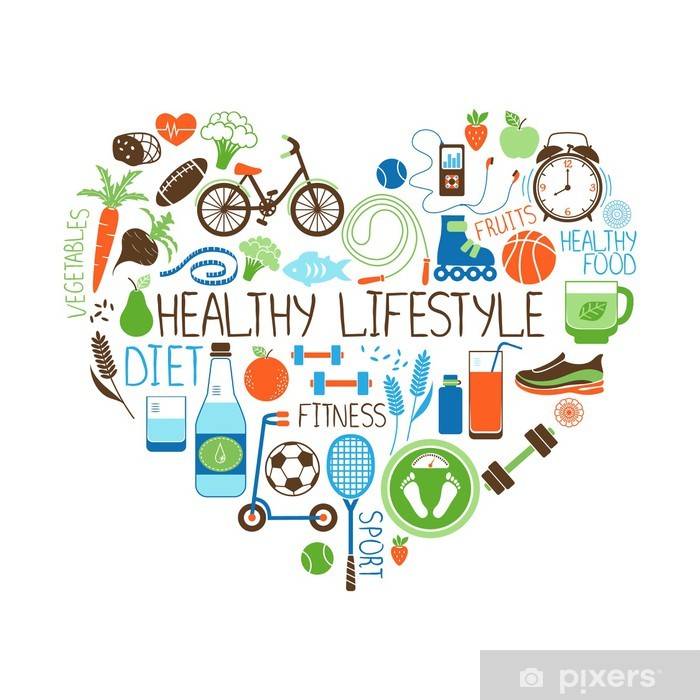Lifestyle Medicine! Yes, you heard it right. If your lifestyle has good habits, then it’s your medicine to prevent disease. In today’s world, we all want to be productive and enjoy our lives to the fullest, and that’s only possible if we adopt healthy lifestyle habits. The healthy lifestyle habits can help us prevent chronic diseases and new modern age diseases: diabetes, hypertension, obesity, addiction, anxiety, depression, tension, hormone imbalances, headaches. You don’t need a pill for these conditions if you just work on a few parts of your lifestyle.
In this blog, you will learn the tips on how to prevent diseases by lifestyle medicine.
1.Eat nutrient dense diet:
You become what you consume. The number one factor to prevent disease is nutrition: to eat the right food in the right proportion at the right time.
What’s the right food? Well, the food which is nutrient-dense is the right food. We have a diverse range of food groups: whole grains, vegetables, fruits, nuts, dairy, and meat. Make your meals with these food groups. A healthy, well-balanced plate has two quarters of veggies and fruits, one quarter with carbs, and last but not least, a quarter full of protein. Have a look at the healthy meal plate, some call it a rainbow plate. Fruits and veggies not only give vibrant color to the plate, in essence, they are filled with fiber and are truly essential for gut health. They fill your stomach, reduce cravings, and are packed with a lot of minerals and vitamins.
What to cut down? Processed and ultra-processed food. They are the foods which are readily available in supermarkets nowadays. They are packaged, have long shelf lives, are high in calories, salt, sugar, and preservatives. The list of some commonly consumed processed foods includes biscuits, pizzas, burgers, fries, gummies and milky chocolates, cakes and confectionaries, bakery products, and ready-made frozen meals.

What’s the right proportion? A healthy, well-balanced plate has two quarters of veggies and fruits, one quarter with carbs, and last but not least is the quarter full of protein. Try to eat in the right proportions and your waistline will remain in control. The other benefit would be you can avoid the most common non-communicable diseases like diabetes, hypertension, and obesity.
What’s the right time? The rule is to eat in the daytime. We heard growing up “early to bed, early to rise” – this has benefits not only for success in life but also for our health. If we follow our circadian rhythm, the normal sleep and wake cycle, we can experience immense benefits. Eating our food between sunset to sunrise is following nature’s way. By following this, we give rest to our digestive system. In this world of electricity, people are using their electronic gadgets, eating high-calorie ultra-processed food in late hours of the night, and they wonder why they suffer from indigestion, heartburn, diabetes, and hypertension. Late-night dinner and snacking and sleeping two hours after the last meal of the day is the simple lifestyle habit that can help with the timing.
2.Move More often:
In today’s world, where we have machines to carry out our daily chores, many have developed a sedentary lifestyle. Lack of adequate movement and exercise can lead to many diseases, the most morbid of these being heart disease, hypertension, obesity, and joint diseases. A 2019 study says, “Exercise is medicine.” So, regular physical activity is an essential lifestyle factor to improve your well-being and prevent disease. The benefits one can gain by being active are tremendous, which includes heart health, weight management, and flexibility.
So, how much movement or exercise should one do? The recommended amount of aerobic activity per week is 150 minutes (2.5 hours) of moderate-intensity exercise, 75 minutes of strenuous exercise, or a mix of the two. There are various types of activities one can adapt according to their state of health, such as walking, running, swimming, or cycling, as well as strength training exercises. According to the interests of the individual, one can also perform yoga or Pilates.
By engaging in regular exercise, not only can one prevent physical ailments, but also keep common mental issues like anxiety and depression at bay. Medical research suggests that people who keep their bodies physically active feel more alive and happier.
3.Take Adequate Sleep:
When making lifestyle improvements, one of the most important things to remember is getting good quality sleep. When we get enough sleep, it can revitalize our bodies. It enhances emotional control, immunity, and cognitive function. What is the suggested sleep duration? For optimum performance, seven to eight hours of sleep each day are thought to be sufficient. Inadequate sleep can worsen long-term conditions, including diabetes and cardiovascular disease, as well as decrease brain function, increase stress, and disrupt mood regulation.
Nowadays, a small percentage of people experience insomnia or lack of sleep, which can worsen as a result of using electronics late at night. Thus, attempt to avoid using a screen two hours before bed to prevent this problem. Getting enough sleep is one of the most crucial things when it comes to health.
4.Manage your Stress:
We are now living in a world where we suffer from different stresses on a daily basis. Job, career, relationships are a few unavoidable stresses which we all encounter. The thought of an ideal life with no worries is what we desire, but reality is opposite to it. In order to reduce our stress, we first need to recognize the factors that cause it. Once we recognize them, then we can work on how to reduce the stress. So, what steps can you take to reduce your stress? Breathing exercises, meditation, yoga, and outdoor walks are a few tools to reduce stress and can make you more productive throughout the day.
5.Stay Away from Drugs:
One of the important tips to prevent disease is to avoid any drugs. The common drugs in which humans can indulge are smoking, alcohol, and recreational drugs. All have harmful effects on the body. Tobacco inhalation, both active and passive, causes cancer along with other chronic respiratory diseases.
People often ask about the safe limit of alcohol intake. Studies show there is no safe limit. Alcohol affects multiple parts of the body including the cardiovascular, gastrointestinal (leading to fatty liver disease), and neurological systems, and is also a cause of cancer.
These drugs can lead to addiction and mental health disorders. It takes a very strong conviction to break free from addiction. The ideal approach is to simply avoid them, but if one develops dependence, then recovery and rehabilitation can be sought out.
6.Say No to Self medication:
Do you know someone who is taking medication for any bodily symptom on the advice of their friend or relative, or were relieved using the same drug before? This is self-medication.
Most commonly, people self-medicate for headaches, heartburn, infections, fever, allergies, body aches, etc. Commonly consumed medicines without prescription are painkillers, antiallergic medications, medications to relieve heartburn, and antibiotics to treat infections. This is something that one should absolutely avoid to prevent any harmful effects of medication. Not only can a few medications cause dependence, but others can also lead to the resistance of effective medication. Opioids, one of the categories of pain-relieving medication, can cause dependence and addiction, and inappropriate use of antibiotics can develop antibiotic resistance. What it means is that when a person actually needs the medicine, it is not effective. So, to prevent disease, one should be very cautious of self-medication.
- Know your family history
“Do you know people who have type 2diabetes, hypertension, heart disease, or obesity that run in their family? All of these are lifestyle diseases. If your first-degree relatives have any of these diseases, then get yourself screened as there is a strong likelihood of you getting these lifestyle-modifiable diseases. In that case, get your blood pressure and blood glucose levels checked. In addition to this, lipid testing can also be done.”
References:
- Awuchi, C. G., Igwe, V. S., & Amagwula, I. O. (2020). Nutritional diseases and nutrient toxicities: A systematic review of the diets and nutrition for prevention and treatment. International Journal of Advanced Academic Research, 6(1), 1-46.
- Khoury SR, Evans NS, Ratchford EV. Exercise as medicine. Vascular Medicine. 2019;24(4):371-374. doi:10.1177/1358863X19850316
- https://www.sciencedirect.com/science/article/abs/pii/S0738399114003000
JAMA Intern Med. 2020;180(5):760-768. doi:10.1001/jamainternmed.2020.0618
Author:
Dr. Maria Aziz
Dr. Maria Aziz is a skilled medical professional with a strong background in emergency medicine and a passion for continuous learning. With qualifications including a WHO-endorsed Diploma in Family Medicine and an MRCP Part 1 from the Royal College, UK. Currently she is a Research Intern at BMY Health.
Committed to both patient care and medical advancement, Dr. Maria Aziz, actively engages in research and education initiatives. She has contributed to clinical audits and research projects, focusing on topics such as emergency department practices and adverse outcomes in poisoning cases. Their keen interest in medical writing, particularly in lifestyle medicine, reflects their commitment to sharing knowledge and promoting wellness.
With a blend of clinical expertise and communication skills, Dr. Maria Aziz is eager & enthusiastic to make meaningful contributions to healthcare and medical literature, aiming to bridge the gap between research and practice.




